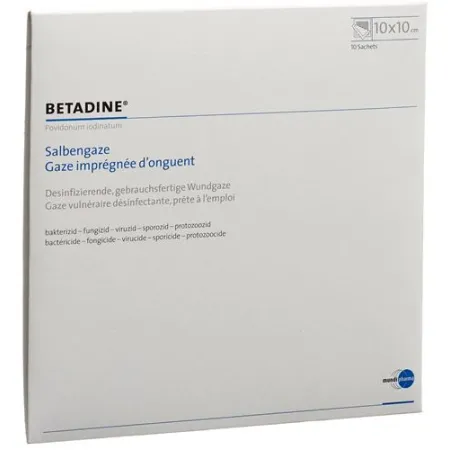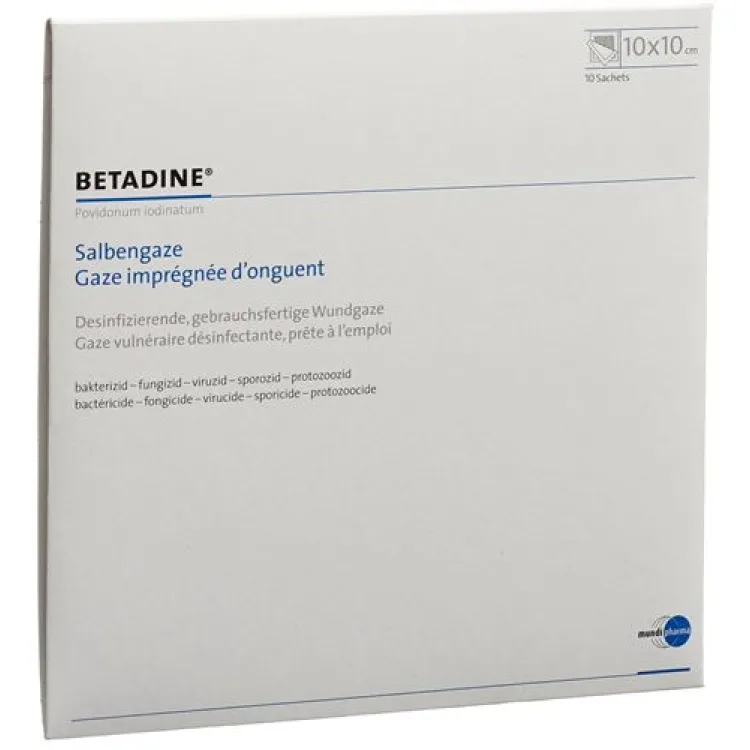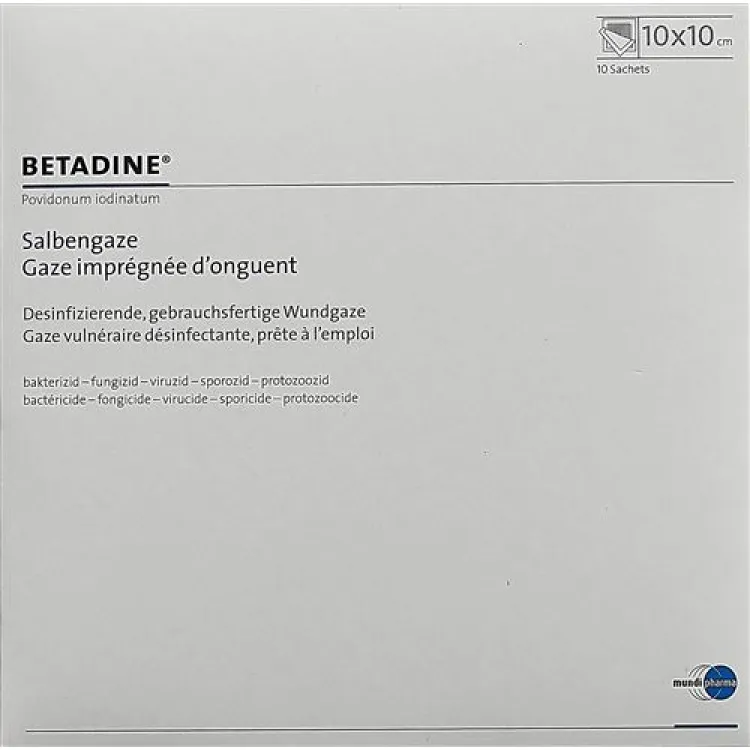Betadine ointment gauze 10x10cm 10 pcs
Betadine Salbengaze 10x10cm 10 Stk
-
34.16 USD

- Availability: Outstock
- Distributor: MUNDIPHARMA MEDICAL
- Brand: Betadine
- Product Code: 1165602
- ATC-code D09AA09
- EAN 7680460900121
Ingredients:
Description
Betadine Ointment Gauze is an air-permeable gauze coated with Betadine disinfecting wound ointment. It kills bacteria, fungi, viruses and other pathogens that cause infection.
Betadine ointment gauze is used to prevent and treat infections in minor wounds, abrasions, skin damage, skin tears and small, minor burns (without blistering).
Exclusively with a doctor's prescription, Betadine ointment gauze is also used to disinfect pressure sores (decubitus), leg ulcers (ulcus cruris) and other infected skin damage.
Swissmedic-approved patient information
Betadine® ointment gauze
AMZV
What is Betadine ointment gauze and when is it used?
Betadine ointment gauze is an air-permeable gauze coated with Betadine disinfecting wound ointment. It kills bacteria, fungi, viruses and other pathogens that cause infection.
Betadine ointment gauze is used to prevent and treat infections in minor wounds, abrasions, skin damage, skin tears and small, minor burns (without blistering).
Exclusively with a doctor's prescription, Betadine ointment gauze is also used to disinfect pressure sores (decubitus), leg ulcers (ulcus cruris) and other infected skin damage.
What should be considered?
Large, heavily soiled and deep wounds as well as severe burns, bites and puncture wounds require medical treatment (including the risk of tetanus spasms) . If the size of a wound remains unchanged for some time during treatment or if the wound does not heal within 10-14 days, a doctor's visit is also necessary; The same applies if the edges of the wound are very red, the wound suddenly swells, is very painful or the injury is accompanied by fever (danger of blood poisoning).
When must Betadine ointment gauze not be used?
Betadine ointment gauze must not be used:
- if you are hypersensitive to povidone-iodine, iodine, macrogol 400 or any other ingredient,
- if you have an overactive thyroid gland or other existing thyroid disease,
- if you have dermatitis herpetiformis Duhring (very rare, herpes-like skin disease),
- before and until the end of an examination or treatment of the thyroid gland with labeled iodine (radio-iodine application). Povidone-iodine can influence the iodine uptake of the thyroid gland, which under treatment with Betadine can lead to disruptions in diagnostic examinations of the thyroid gland (thyroid scintigraphy, determination of the iodine bound to proteins, radio-iodine diagnostics) and a planned radio- make iodine therapy impossible. There should be an interval of at least 1-2 weeks after stopping treatment with Betadine ointment gauze before applying radioiodine;
- in newborns and infants under 6 months.
When is caution required when using Betadine ointment gauze?
Betadine should only be used in the case of thyroid enlargement or nodules or other non-acute diseases of the thyroid gland on the express prescription of your doctor or your doctor over a longer period of time (e.g. longer than 14 days) or over a large area (e.g. more than 10% of the body surface). Even after the end of treatment (up to 3 months) one should pay attention to early symptoms of possible hyperthyroidism and monitor thyroid function if indicated.
Betadine is for use in infants and young children aged 6 months to 6 years only with a doctor's prescription. Thyroid function may need to be checked. Any ingestion of Betadine by a child should be avoided at all costs.
Betadine should not be used or used if the blood is too acidic due to metabolism (metabolic acidosis) and kidney failure. treatment to be discontinued.
Betadine must not be used at the same time as or shortly after enzymatic wound treatment agents or disinfectants containing silver sulfadiazine, hydrogen peroxide or taurolidine, as there is a mutual weakening of the effect.
Betadine must not be used at the same time as or shortly after mercury-containing disinfectants, as under certain circumstances a substance can form from iodine and mercury that damages the skin.
Do not use Betadine at the same time as or immediately after using disinfectants containing octenidine on the same or adjacent areas, as this may cause temporary dark discolouration.
If you are being treated with lithium preparations, you should avoid long-term or extensive use of Betadine, as absorbed iodine can promote lithium-induced hypothyroidism.
Inform your doctor, pharmacist or druggist if you suffer from other illnesses, have allergies or are taking other medicines (even those you bought yourself!) or using them externally!
Can Betadine ointment gauze be used during pregnancy or while breastfeeding?
During pregnancy and while breastfeeding, you should only use Betadine ointment gauze on the express prescription of a doctor and on the limit the absolute minimum. Monitoring of thyroid function in the newborn or infant may be required. Accidental ingestion of Betadine by the infant through the mouth through contact with the treated part of the nursing mother's body must be avoided. Tell your doctor, pharmacist or druggist if you are pregnant or breastfeeding.
How do you use Betadine ointment gauze?
Adults, adolescents and children from the age of 6
If your doctor or Unless otherwise instructed by your doctor, apply Betadine Ointment Gauze as follows:
Tear the bag open carefully. Carefully remove the gauze, preferably with the help of tweezers, and place it flat on the skin area or wound to be treated. If necessary, cover with bandage.
Renew Betadine ointment gauze at every dressing change. In the initial phase or in the case of heavily infected or secreting wounds and rapid discoloration of the gauze, it should be changed several times a day.
Children from 6 months to 6 years
Betadine must not be used in newborns and infants under 6 months (see the section «When must Betadine ointment gauze not be used?») . For small children up to 6 years of age, only use if prescribed by a doctor (see the section "When should you be careful when using Betadine ointment gauze?").
As long as the golden-brown color of the betadine is visible, the ointment gauze has a disinfecting effect. Discoloration means a decrease in effectiveness and signals that a new application should take place. Therefore, remove the old ointment gauze and put on a new one if you notice a clear discoloration.
Betadine ointment gauze can be used several times a day. Continue treatment until healing.
If your symptoms have not improved after several days (2-5 days) of regular use, or if symptoms recur after completing treatment, you should see your doctor.
Follow the dosage given in the package leaflet or as prescribed by your doctor. If you think the medicine is too weak or too strong, talk to your doctor, pharmacist or druggist.
What side effects can Betadine ointment gauze have?
In rare cases, hypersensitivity or contact dermatitis (with symptoms such as reddening of the skin, blisters, itching) can occur.
In very rare cases, acute, painful swelling of the skin or mucous membranes (angioedema) and acute general allergic reactions may occur with a drop in blood pressure and/or shortness of breath (anaphylactic reaction). In such cases, treatment with Betadine should be stopped immediately and the doctor informed immediately.
Significant iodine uptake may occur with prolonged use on extensive areas of skin, wounds or burns. In very rare cases, patients with thyroid disorders may experience hyperthyroidism with symptoms such as increased heart rate or inner restlessness.
In individual cases, hypothyroidism, disturbances in the electrolyte balance, metabolism-related hyperacidity of the blood (metabolic acidosis), acute kidney failure and abnormal blood osmolarity can occur.
If you notice side effects that are not described here, you should inform your doctor, pharmacist or druggist.
What else needs to be considered?
Store at room temperature (15-25 °C) and out of the reach of children.
Betadine ointment gauze is fat-free. Residues of ointment can be washed off with water.
Betadine stains can be washed out of natural fibers with soap and water, and out of synthetic fibers with diluted ammonia or sodium thiosulphate solution.
The medicinal product may only be used up to the date marked «EXP» on the container.
Your doctor, pharmacist or druggist can provide you with further information. These people have the detailed information for specialists.
What does Betadine ointment gauze contain?
A gauze is coated with 3 g of ointment. 1 g ointment contains 10 mg iodine as povidone iodine.
Excipients: Ointment base with Makrogol 400 and other excipients.
Approval number
46090 (Swissmedic).
Where can you get Betadine Ointment Gauze? What packs are available?
In pharmacies and drugstores, without a doctor's prescription.
Boxes of 10 individually wrapped ointment gauzes (10×10 cm).
Authorization holder
Mundipharma Medical Company, Hamilton/Bermuda, Basel branch.
This leaflet was last checked by the drug authority (Swissmedic) in May 2016.





